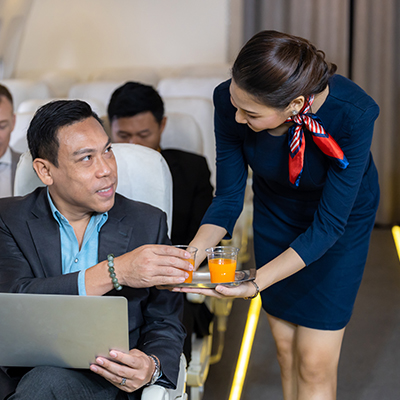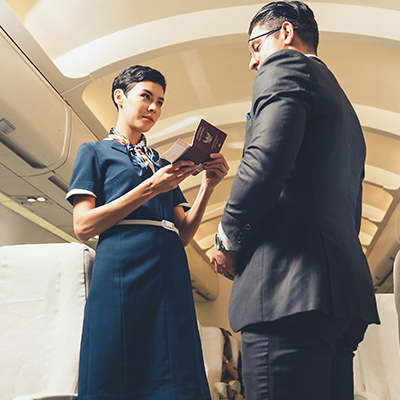An inflight trip refers to the experience of passengers and crew aboard an aircraft during the course of a flight. It includes everything that happens from the moment the plane takes off until it lands at the destination. Below is a breakdown of the key components of an inflight trip, from both the passenger and cabin crew perspectives.
Boarding Process: Passengers board the plane based on the airline’s boarding protocol (by class, row, or status). Once aboard, they locate their seats, stow carry-on luggage, and prepare for the flight.
Seat Assignment: Passengers usually sit in pre-assigned seats, which may vary from economy to business or first-class, with each class offering different levels of comfort, space, and service.
Safety Briefing: Prior to takeoff, the cabin crew demonstrates safety procedures, including how to use seat belts, oxygen masks, and life vests, along with emergency exits. This is crucial to ensure passenger safety throughout the flight.
Safety Regulations: Passengers are reminded to keep seat belts fastened during takeoff, landing, and when instructed by the crew. Electronic devices may be required to be switched to airplane mode.

Entertainment Systems: Many airlines offer inflight entertainment options, including movies, TV shows, music, games, and more. In higher classes, entertainment systems may be available on individual screens, while some economy flights offer shared screens.
Wi-Fi and Connectivity: Many modern aircraft offer Wi-Fi services to allow passengers to stay connected during the flight. Passengers may be able to browse the web, use messaging apps, and access email, though availability and speed vary depending on the airline.
Meal Service: Airlines typically provide meal services during longer flights, with meal options varying by class and flight duration. First and business class often offer gourmet meals, while economy passengers receive standard airline meals. Dietary preferences, such as vegetarian or gluten-free, are usually available upon request.
Beverage Service: Complimentary beverages, including water, juice, coffee, tea, and sometimes alcoholic drinks, are offered. Premium passengers may have access to a wider selection of wines, spirits, and specialty beverages.
Blankets and Pillows: Passengers on long-haul flights may receive blankets, pillows, and amenity kits (which could include toiletries, socks, and eye masks) to ensure comfort during the flight.
Seat Adjustments: Seats in economy may recline slightly for relaxation, while business and first-class seats may convert into fully flat beds, providing additional comfort for long flights.
Lavatories: Inflight lavatories are available for passenger use. They are equipped with basic toiletries and amenities, and crew members ensure they are maintained during the flight.
Flight Information: Throughout the flight, passengers can monitor flight progress, including estimated arrival time, altitude, speed, and location
Jet Lag Management: On long-haul flights, time zone changes can affect passengers. Some airlines offer advice or amenities (such as lighting adjustments) to help mitigate the effects of jet lag.
Medical Emergencies: If a medical emergency occurs during the flight, the cabin crew is trained to administer first aid, and some aircraft are equipped with medical kits and defibrillators.
Assistance for Families: Airlines often provide special services for families traveling with children, including bassinets, children’s meals, and entertainment options for kids.
Briefing: Before the flight, the cabin crew attends a pre-flight briefing, where they discuss safety protocols, service standards, and any specific requirements for the upcoming flight, including VIP passengers or medical conditions.
Cabin Check: The crew ensures that the cabin is clean, all safety equipment is functioning properly, and that the food and beverage services are prepared.
Seating and Baggage: Crew members assist passengers with finding their seats and storing their luggage in overhead bins.
Safety and Comfort: Cabin crew monitors passengers during the flight to ensure compliance with safety regulations and to address any needs, such as providing blankets or addressing special requests.

Meal and Beverage Service: The crew serves meals and beverages at specific intervals during the flight, ensuring passengers' needs are met. They also handle special requests, such as dietary requirements or additional food and drinks.
Entertainment Assistance: Crew members help passengers with operating inflight entertainment systems and offer recommendations for content where applicable.
Medical Situations: Cabin crew are trained to handle medical emergencies, such as fainting, illness, or other incidents, providing first aid and contacting ground services if necessary.
Dealing with Unruly Passengers: Crew are responsible for managing any unruly or disruptive passengers to maintain a safe and peaceful environment on the flight.
Landing Preparations: Prior to landing, the cabin crew ensures that passengers are seated, seat belts are fastened, tray tables are stowed, and all carry-on items are secured.
Final Announcements: Crew members provide final announcements regarding arrival, customs procedures, and other relevant information for passengers to prepare for landing.
Deboarding: After the aircraft has safely landed and reached the gate, passengers are guided to deboard the aircraft in an orderly manner, starting with first-class and business-class passengers, followed by economy class.
Baggage Retrieval: Passengers proceed to baggage claim to retrieve checked luggage. Airlines may offer assistance for passengers with connecting flights.
Luxury and VIP Flights: Premium flights, such as those on private jets or in first class, offer a more exclusive experience with personalized service, high-end meals, and more spacious, luxurious seating.
Long-Haul and Transatlantic Flights: These flights may offer additional amenities, such as extra meal services, sleeping arrangements, and entertainment to ensure passenger comfort over longer durations.